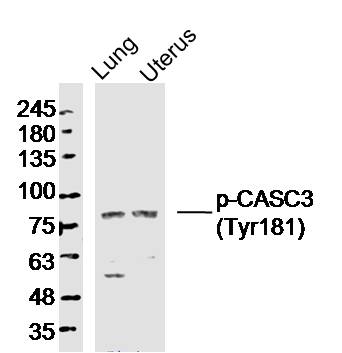
Rabbit Anti-phospho-CASC3 (Tyr181)antibody
CASC3 (phospho Tyr181); CASC3 (phospho Y181); Barentsz protein; Btz; Cancer susceptibility candidate gene 3 protein; Metastatic lymph node protein 51; MLN 51 protein; MLN51; Protein barentsz; Protein CASC3; Protein MLN 51; CASC3_HUMAN.
View History [Clear]
Details
Product Name phospho-CASC3 (Tyr181) Chinese Name 磷酸化Tumour易感候选基因3抗体 Alias CASC3 (phospho Tyr181); CASC3 (phospho Y181); Barentsz protein; Btz; Cancer susceptibility candidate gene 3 protein; Metastatic lymph node protein 51; MLN 51 protein; MLN51; Protein barentsz; Protein CASC3; Protein MLN 51; CASC3_HUMAN. Product Type Phosphorylated anti Research Area Tumour Cell biology immunology Immunogen Species Rabbit Clonality Polyclonal React Species Mouse, (predicted: Human, Rat, Chicken, Pig, Cow, Horse, Rabbit, ) Applications WB=1:500-2000 ELISA=1:5000-10000 IHC-P=1:100-500 IHC-F=1:100-500 IF=1:100-500 (Paraffin sections need antigen repair)
not yet tested in other applications.
optimal dilutions/concentrations should be determined by the end user.Theoretical molecular weight 76kDa Cellular localization The nucleus Form Liquid Concentration 1mg/ml immunogen KLH conjugated Synthesised phosphopeptide derived from human CASC3 around the phosphorylation site of Tyr181: PA(p-Y)IP Lsotype IgG Purification affinity purified by Protein A Buffer Solution 0.01M TBS(pH7.4) with 1% BSA, 0.03% Proclin300 and 50% Glycerol. Storage Shipped at 4℃. Store at -20 °C for one year. Avoid repeated freeze/thaw cycles. Attention This product as supplied is intended for research use only, not for use in human, therapeutic or diagnostic applications. PubMed PubMed Product Detail The multiprotein exon junction complex (EJC) is deposited on mRNAs upstream of exon–exon junctions as a consequence of pre-mRNA splicing. In mammalian cells, this complex serves as a key modulator of spliced mRNA metabolism. MLN51 is a nucleocytoplasmic shuttling protein that is overexpressed in breast cancer. The function of MLN51 in mammals remains elusive. Its fly homolog, named barentsz, as well as the proteins mago nashi and tsunagi have been shown to be required for proper oskar mRNA localization to the posterior pole of the oocyte. Magoh and Y14, the human homologs of mago nashi and tsunagi, are core components of the exon junction complex (EJC). The EJC is assembled on spliced mRNAs and plays important roles in post-splicing events including mRNA export, nonsense-mediated mRNA decay, and translation. Human MLN51 is an RNA-binding protein present in ribonucleo-protein complexes.
Function:
Component of a splicing-dependent multiprotein exon junction complex (EJC) deposited at splice junction on mRNAs. The EJC is a dynamic structure consisting of a few core proteins and several more peripheral nuclear and cytoplasmic associated factors that join the complex only transiently either during EJC assembly or during subsequent mRNA metabolism. Core components of the EJC, that remains bound to spliced mRNAs throughout all stages of mRNA metabolism, functions to mark the position of the exon-exon junction in the mature mRNA and thereby influences downstream processes of gene expression including mRNA splicing, nuclear mRNA export, subcellular mRNA localization, translation efficiency and nonsense-mediated mRNA decay (NMD). Stimulates the ATPase and RNA-helicase activities of EIF4A3. Plays a role in the stress response by participating in cytoplasmic stress granules assembly and by favoring cell recovery following stress. Component of the dendritic ribonucleoprotein particles (RNPs) in hippocampal neurons (By similarity). May play a role in mRNA transport (By similarity). Binds spliced mRNA in sequence-independent manner, 20-24 nucleotides upstream of mRNA exon-exon junctions. Binds poly(G) and poly(U) RNA homopolymer.
Subunit:
Forms homooligomers (By similarity). Interacts with STAU in an RNA-dependent manner (By similarity). Part of the EJC core complex that contains CASC3, EIF4A3, MAGOH and RBM8A. Found in a mRNA splicing-dependent exon junction complex (EJC), at least composed of ACIN1, CASC3, EIF4A3, MAGOH, PNN,
Subcellular Location:
Cytoplasm, perinuclear region. Nucleus. Nucleus speckle. Note=Predominantly found in the perinuclear region (By similarity). Shuttles between the nucleus and the cytoplasm in a CRM1-dependent manner. Travels to the cytoplasm as part of the exon junction complex (EJC) bound to mRNA. Shuttles between the cytoplasm and the stress granules. More specifically found in nuclear intrachromatin granules clusters (IGC), also called nuclear speckles, which are storage compartments for nuclear proteins involved in mRNA processing. Colocalizes in nuclear speckles with MAGOH. Under stress condition, colocalizes with FMR1 and TIA1, but not MAGOH and RBM8A EJC core factors, in cytoplasmic stress granules, which contain stored mRNAs whose translation is stopped in response to stress.
Tissue Specificity:
Widely expressed. Overexpressed in breast cancers and metastasis, as well as in gastric cancers. [DOMAIN] The coiled coil domain may be involved in oligomerization.
Post-translational modifications:
ADP-ribosylated by tankyrase TNKS and TNKS2. Poly-ADP-ribosylated protein is recognized by RNF146, followed by ubiquitination.
Ubiquitinated by RNF146 when poly-ADP-ribosylated, leading to its degradation.
Similarity:
Belongs to the CASC3 family.
SWISS:
O15234
Gene ID:
22794
Database links:
Entrez Gene: 22794 Human
Entrez Gene: 192160 Mouse
Omim: 606504 Human
SwissProt: O15234 Human
SwissProt: Q8K3W3 Mouse
Unigene: 592129 Human
Unigene: 40120 Mouse
Unigene: 162194 Rat
Product Picture
References (0)
No References
Bought notes(bought amounts latest0)
No one bought this product
User Comment(Total0User Comment Num)
- No comment



 +86 571 56623320
+86 571 56623320
 +86 18668110335
+86 18668110335

